
The Nun Anastasia
Commemorated on March 10
The Nun Anastasia
lived in Constantinople and was descended from an aristocratic family. The
pious patrician was for many the image of virtue and she enjoyed the great
esteem of the emperor Justinian (527-565). Having early been widowed, Anastasia
decided to leave the world and save her soul far off from the bustle of the
capital. She secretly abandoned Constantinople and set off to Alexandria. She
founded a small monastery not far from the city and devoted herself wholly to
God.
Several years later
the emperor Justinian was widowed and decided to seek out Anastasia so as to
marry her. Having learned of this, blessed Anastasia immediately set out to a
remote skete monastery to abba Daniel (Comm. 18 March) for help. In order to safeguard
Anastasia, the elder dressed her in a man's monastic garb and called her the
eunuch Anastasias. Having settled her in one of the very remote caves, the
elder gave her a rule of prayer and ordered her never to leave the cave and
receive no one. Only one monk knew this place: he had the obedience once a week
to bring to the cave a small portion of bread and a pitcher of water, leaving
it at the entrance. The nun Anastasia dwelt in suchlike seclusion for
twenty-eight years. Everyone reckoned that in the cave it was the eunuch
Anastasias that pursued asceticism.

The Lord revealed to
her the day of her death. Having learned of immanence of death, she wrote on a
potsherd several words for abba Daniel and placed it at the entrance to the
cave. The starets (elder) came quickly and brought everything necessary for her
burial. He found the holy ascetic still alive, and he confessed and communed
her with the Holy Mysteries. At the request of the abba, blessed Anastasia
blessed him and the monk accompanying him. With the words: "Lord, into Thy
hands I commend my spirit", – the saint quietly died (+ c. 567-568).
When the grave was
prepared, the starets gave his disciple a riasa and ordered him to dress the
deceased brother. Putting on the riasa, the monk realised that before him was a
woman, but he did not dare to say anything. When however they returned to the
monastery, having buried the nun, the disciple asked the abba whether he knew
the supposed brother – was a woman, and the elder related to the young monk
the history of Saint Anastasia. Later on the narratives of the abba were
written down and received wide acclaim.
The relics of the nun
Anastasia were transferred in the year 1200 to Constantinople, and put not far
from the temple of Saint Sophia.
© 1996-2001 by translator Fr. S. Janos.